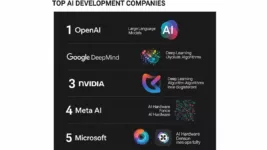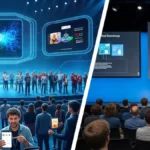Here in Bend, Oregon, where the rapid currents of technological change are a constant topic of conversation, Microsoft finds itself at a critical juncture in the burgeoning AI revolution. The company, a titan of the computing age, faces a leadership challenge in navigating this transformative landscape, a situation that bears an intriguing, if somewhat concerning, resemblance to its early stumbles in the nascent days of the internet.
Deja Vu: The Ghost of Internet Explorer Past?
Decades ago, Microsoft was initially slow to recognize the seismic shift of the World Wide Web and found itself playing catch-up. It wasn’t until Bill Gates’ now-legendary “Internet Tidal Wave” memo that the entire company executed a swift and decisive pivot, ultimately leveraging its dominant position in operating systems to propel Internet Explorer to ubiquity. Today, AI promises a similar, if not greater, reshaping of technology, and Microsoft’s response feels… different. While its investment in and partnership with OpenAI has positioned it as a visible player, the internal mobilization and overarching strategic clarity seem less akin to a unified charge and more like a cautious dipping of toes.
The Complexity Conundrum: A Bigger Ship to Turn
In 2025, the reality is that Microsoft is a vastly more complex and sprawling entity than the Microsoft of the mid-1990s. Its tentacles reach into cloud computing (Azure, a clear leader), enterprise software, gaming (Xbox), and a vast array of productivity tools. This complexity, while a strength in many ways, can also breed inertia and siloed priorities. While Azure has undeniably embraced and integrated AI with impressive speed and efficacy, the same level of AI-driven transformation doesn’t yet feel pervasive across the company’s other core offerings.
The elephant in the digital living room is the potential for AI to fundamentally alter the very foundations upon which Microsoft built its empire. If truly intelligent AI assistants become the primary interface for interacting with technology, the traditional operating system paradigm, the very essence of Windows, could face an existential challenge. Similarly, while Microsoft Office now sprinkles in some AI-powered features, its core document-centric model might feel increasingly antiquated in a world where AI can generate, summarize and analyze information with unprecedented speed and natural language understanding. On the desktop, the rollout of Microsoft’s “AI PC” initiative, while promising, appears to be lagging in terms of truly compelling, AI-native applications (few use Co-Creator and Recall is still unreleased nearly a year after launch). The lack of a killer “Copilot +” app ecosystem to truly showcase the potential of these AI-infused machines raises questions about the company’s immediate vision for the AI-powered personal computing experience.
The Ive/OpenAI Wildcard: A Potential Eclipse?
Adding another layer of uncertainty is the recent merger of Jony Ive’s design powerhouse, IO, with OpenAI. Ive’s track record of creating paradigm-shifting hardware at Apple, when coupled with OpenAI’s cutting-edge AI research, presents a potentially seismic threat to the established tech order. Imagine a completely reimagined personal device, designed from the ground up with AI as its core, unburdened by the legacy constraints of the PC and smartphone eras. Such a device could potentially eclipse not just the existing PC market but even the smartphone, offering a truly seamless and intuitive AI-driven experience that renders traditional operating systems and application-based interactions obsolete. For Microsoft, whose dominance has long rested on these very pillars, this is a competitive wildcard that cannot be ignored.
The AI Power Rankings: Where Does Microsoft Truly Stand?
So, in this rapidly evolving landscape, where does Microsoft truly rank among the top AI companies? While definitive rankings are fluid and depend on the metrics used, a current assessment might look something like this (I’m excluding China at the moment due to the related tech restrictions, but they are moving fast on AI and could easily dominate this segment in a few short years):
- OpenAI: As the creators of GPT models, it holds a significant lead in foundational AI research and public awareness.
- Google (Google DeepMind): Possessing immense research capabilities, a vast data ecosystem and increasingly impressive multimodal models like Gemini, Google is a formidable AI force.
- NVIDIA: The undisputed king of AI hardware; its GPUs power the vast majority of AI training and inference workloads.
- Meta AI: With significant open-source contributions (like Llama) and a deep investment in AI research for its metaverse and social platforms, Meta is a major player.
- Microsoft: While possessing significant cloud infrastructure (Azure AI) and a crucial partnership with OpenAI, Microsoft’s own foundational AI research and its pervasive integration of AI across its core product lines still feels like it’s playing catch-up in certain areas.
Wrapping Up:
While Microsoft is undoubtedly a major investor and enabler of AI, whether it is currently leading the charge in terms of fundamental AI innovation and its seamless integration into its core user experiences remains an open question. The ghost of Internet Explorer’s start serves as a cautionary tale. The complexity of Microsoft’s current empire demands a unified and decisive AI strategy that permeates every facet of the company, not just its cloud division. The potential disruption from the Ive/OpenAI alliance further underscores the urgency. Microsoft needs to ensure it’s riding the AI tidal wave, not merely caught in its undertow, lest it find itself once again playing catch-up in a future it helped to envision.








